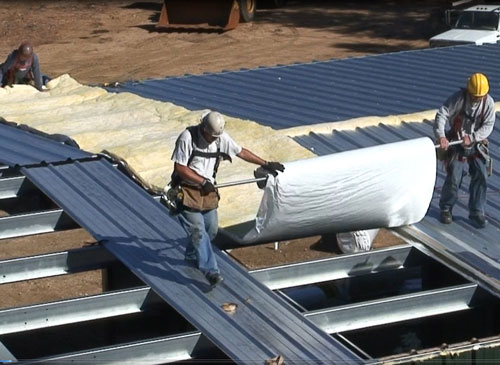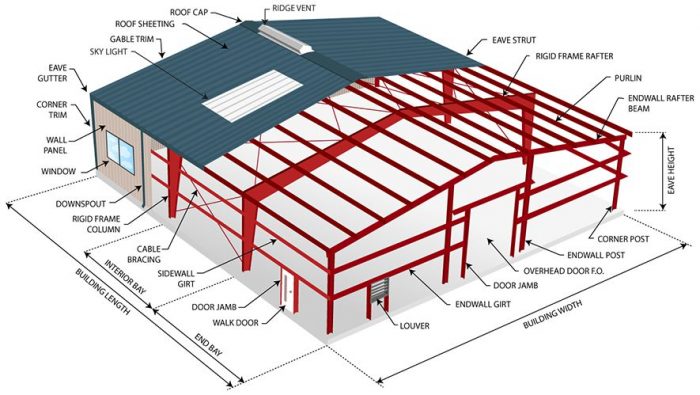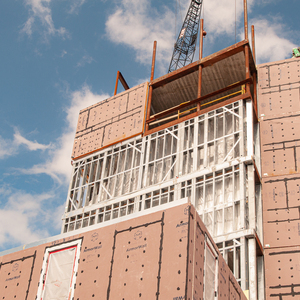
Most metal buildings (also known as steel buildings) are used for relatively utilitarian purposes — for example, as warehouses, auto repair shops, or manufacturing facilities. That said, it’s possible for a metal building to have a completely finished interior, in which case the building can be used as a retail store or even a high-end home.
Metal buildings have a post-and-beam steel frame (steel columns and rafters) overlaid on the exterior of the walls by horizontal steel girts. Steel purlins are installed above the rafters. To complete the system, the walls and roof are covered by steel panels.
Metal buildings have certain advantages: they allow for wide spans without intervening columns or supporting walls, and they’re relatively inexpensive. They also have a few disadvantages: the buildings’ fat columns can be hard to hide or disguise, and most metal buildings have an unsophisticated approach to insulation and air sealing.
Compared to wood-frame buildings, steel buildings are notable for their lack of wall sheathing or roof sheathing. For builders concerned with air sealing details or advanced insulation methods, the lack of sheathing raises a few concerns.
For insulation, use MBI
Most metal buildings are insulated with a product called MBI. You’re probably wondering, “What’s MBI?” That’s simple: MBI stands for Metal Building Insulation. Basically, it’s fiberglass insulation adhered to a white vinyl vapor barrier.

[Image credit: CertainTeed — https://www.certainteed.com/resources/mb316.pdf]This method is fast and easy, but it introduces a major thermal weakness in…
Weekly Newsletter
Get building science and energy efficiency advice, plus special offers, in your inbox.

This article is only available to GBA Prime Members
Sign up for a free trial and get instant access to this article as well as GBA’s complete library of premium articles and construction details.
Start Free TrialAlready a member? Log in















18 Comments
The big advantage to metal buildings like this and pole buildings using wood posts is that the basic shell is very inexpensive. The companies that provide materials buy in bulk, installers are very efficient and engineering is provided much cheaper than other types of buildings. Additionally, these buildings typically eliminate most of the foundation and concrete that goes with it. This leaves a lot of money to work on air sealing and insulation if you want a more energy efficient building. There is no reason why you can’t achieve good levels using higher end air barriers on the interior, good housewraps on the exterior, sheathing, and mineral wool insulation or unfazed fiberglass blankets etc. This adds to cost but it still ends up cheaper and may be a good choice if you like the look
Nick,
If you do decide to go beyond their strengths as utilitarian buildings and upgrade them the way you describe, you invariable need to infill the spaces between the load-bearing structure with studs to support cladding, insulation, air-barriers, etc. The studs necessary to do this can usually act as the structure on their own, making the original post and beam elements redundant.
Thee are lots of proprietary infill panels, but thy are designed for large commercial structures, and usually aren't available for small buildings.
My own feeling is it's best to stick to the uses and limitations Martin outlines. Once you go beyond them it's better to use another building type altogether.
Malcolm,
I agree. The limitations of metal buildings are similar to the limitations of timber-framed buildings. If you end up needing stud walls, the question arises: Why even bother with the steel framing or the timber framing? After all, the studs could carry the loads.
Martin,
The failed insulation pictures are interesting. I worked on a flat-roofed metal building with similar enclosed batts. As flat roofs almost inevitably do at some point, it began to leak, and while re-roofing was fairly simple, replacing the batts required a completely new approach.
You’re probably wondering, “What’s MBI?” That’s simple: MBI stands for Metal Building Insulation. Basically, it’s fiberglass insulation adhered to a white vinyl vapor barrier.
Don't know if this is a regional colloquialism, but it's often called 'bag and sag' insulation around here.
This method is fast and easy, but it introduces a major thermal weakness in the building exterior: at the girts and purlins, the insulation gets squished, greatly lowering the insulation R-value at those locations. The result is thermal bridging at the girts and purlins.
A couple of good purlin thermal bridging shots below. Sun hitting the roof, heating the steel through the compressed insulation.
By far the most common method of insulating a steel building is with fiberglass insulation (MBI). That said, some owners hire a foam contractor to install spray polyurethane foam directly against the interior side of the steel wall panels and roof panels. I don’t recommend this approach, for two reasons:
Both good points. However, I've recommended doing an exterior spray foam job (per the SPFA details) on an existing steel building roof, because it deals with both (a) wintertime condensation inside the roof sandwich, and (b) dealing with the existing roof leakage problems. It also reduces thermal bridging issues. It is intended as, "Let's figure out how to stay in this building while dealing with the worst problems."
Kohta,
Thanks for the excellent photos and comments. Using spray polyurethane foam as roofing is an excellent approach, although it isn't cheap. Spray foam roofing does, indeed, solve roof leaks, air leaks, and thermal bridging. It works.
@Martin Holladay, are you available for a consultation? I've read your article about unvented crawl spaces, among other articles, and have several questions. We have just cleared our lot and are getting ready to build. I'd like to review our plans and be sure we're doing our due diligence living in muggy Florida. Please advise. Thanks! Genevieve
Genevieve,
I'm a journalist, not a consultant. Moreover, I'm retired.
If you have any questions, post them on the Q&A page here at GBA. You'll get free advice from a variety of sources. Here is the link:
https://www.greenbuildingadvisor.com/post/question
Perhaps you can help us, we have built a 36x42' Quonset style home and are stalled by the insulation process. We lose so much interior space with fiberglass insulation. 12" to be exact. We were wondering if anyone had used ceramic paint as a thermal/vapor barrier? Super Therm sells this paint and we were thinking it might keep the condensation down and also help reduce our R value requirements. Any suggestions?
Cyndi,
Super Therm paint is a scam. There is no such thing as "insulating paint." For more information, see "An ‘Insulating’ Paint Salesman Is Tripped Up By His Own Product."
I know it's too late in your case, but I'm going to use this opportunity to let other GBA readers know that insulation decisions have to be finalized before construction begins. For more information on this topic, see "Plan Ahead for Insulation."
One of the main reasons I recommend using closed cell foam in a metal building is that it eliminates steel panels from rusting. In standard MBI applications, most metal buildings experience major condensation issues especially in the South. The condensation causes sags and tears and often leads to insect and animal infestation. My company bids spray foam insulation on many new metal buildings and most times the owner is not interested in paying the additional cost for the spray foam. You would be surprised at how many times the building owner later pays us to remove the MBI and install closed cell foam. The comfort, durability, and energy savings from a properly spray foamed and detailed air sealing package make it the best option in my opinion.
Are you making a move to HFO foams? Are commercial customers asking for this in your area, or do they even know it is an option?
The combustibility of vinyl facings was discussed in this article. Indeed they do not provide much fuel during a fire. The contribution of thermoplastic materials should not be ignored, however. A fire that progresses on the inside surface of a wall or roof may not be considered severe based on the low fuel contribution of the vinyl facing. However, this facing is a thermoplastic that can ignite and melt, which can then drip onto and ignite combustible materials stored in the building. This behavior is not always characterized by current fire testing protocols.
I have been considering using a metal building with spray foam insulation. I’m in North Florida and concerned with both condensation and air infiltration. Can any of you point me in the direction of a wall section for air sealing a metal building (I’m new to the site please forgive me)?
Chris,
I don't have access to such a wall section. In your case, the spray foam will be the air barrier. As with all spray foam jobs, the leaks (if any) will occur at penetrations and seams -- for example, at the seam between the walls and the concrete slab.
You might want to hire an energy consultant (someone familiar with the operation of a blower door) as a consultant to supervise the air sealing details.
Thanks for the information Martin. Would you recommend a Particular caulking product or taping product that would better adhere to metal for the leaky seams and around window and door frames?
Chris,
If your spray foam contractor can install spray foam up to your window frames and door frames, there shouldn't be any air leaks. That said, if you need to use tape that adheres well to steel, I recommend Tescon Vana. Here is a link to a web page with more information: Tescon Vana tapes.
I'm currently working on a typical metal building just like Martin described that is the main exhibit hall at our fairgrounds. Zone 6B. Cold, windy and dry climate. It has 1" vinyl faced FG insulation, 8" horizontal girts and purlins and an uninsulated slab. The County is looking at insulating the building so that it can be used on a more regular basis. I'm considering vertical 2x4s on 24"oc attached to the girts, dense packed insulation, then drywall. It probably overkill as far as the insulation goes but I can't think of another economical solution that covers the metal girts and allows finishing the interior. I'm now thinking about the contact point between the exterior metal siding/roofing and the insulation. Should I remove the vinyl which would be buried on the cold side of the insulation? Should I be worried about moisture buildup on the metal? Any other possible solutions?
Log in or become a member to post a comment.
Sign up Log in